| [ Team LiB ] |
|
2.5 Class DiagramsRepresenting the domain model for an application is arguably the most important area of object-oriented modeling. Class diagrams, as a result, are the most widely used feature of the UML. Class diagrams show the relationships between classes in a system. Since object-oriented design blurs the line between data objects and executable application logic, a UML class diagram documents both. UML actually supports both class diagrams and object diagrams. If you're reading this book, you're almost certainly familiar with the distinction between a class and an object: a class is a framework containing methods and data that can be instantiated into one or more objects, which contain actual data items. UML class diagrams show the relationship between the frameworks, and object diagrams show the state of a system with actual objects, containing actual values. Although the names are the same, a class in a UML class diagram does not necessarily map to a Java class—although in more detailed, design-focused UML diagrams, they will. Class diagrams can be used to build conceptual pictures of an application's domain model, which can then be used to develop more specific system designs that eventually map into code. It's nice to be as complete as possible when developing a class diagram, but it is by no means necessary. Generally, a modeler picks a level of completeness that corresponds with the current stage in the software design process. The highest level class diagrams ignore all private methods and internal data structures, focusing instead on the logical content of the objects. The diagram in Figure 2-6 illustrates a single class, in fairly high detail. The first compartment of the box holds the class name. The second compartment identifies the fields within the class, and the third compartment includes the methods in the class. In UML terminology, these are referred to as the attributes and operations of the class, respectively. Each of the fields and methods has a visibility modifier: +, -, or # for public, private, and protected. A colon and a variable type to indicate the storage or return types can follow both fields and methods. Figure 2-6. Class diagram of a single class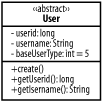 With the exception of the top compartment, each section is optional. Some modelers leave all three compartments in place for clarity, while other modelers omit the middle (fields) compartment if they are modeling at a high level. In addition to the class name, the class name compartment contains the «abstract» stereotype, indicating that the class is abstract. Since stereotypes modify whatever follows them, we put the «abstract» stereotype above the class name rather than below. 2.5.1 Relationships Between ClassesAside from detailing the attributes and operations of particular classes, UML class diagrams can also indicate the relationships between classes. The two basic associations possible between classes are a dependency and a generalization. Dependencies indicate that a class makes use of another class as part of a data relationship. Generalizations correspond to class inheritance, much as we saw for use cases. Figure 2-7 shows a set of classes for an implementation of our user registration scheme. Figure 2-7. Basic class diagram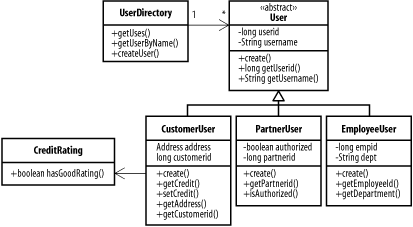 The diagram above shows two key aspects of the association between the UserDirectory and User classes. The first is the navigability of the relationship, indicated by the direction of the arrow. Drawing the arrow pointing from UserDirectory to User indicates that the UserDirectory has access to all associated User objects, but that User objects do not see the UserDirectory they are a part of. The diagram also indicates the multiplicity of the relationship between UserDirectory and User via the labels on each end of the association. The 1 next to UserDirectory indicates that for any given User object there is one UserDirectory, while the * on the User end indicates that there can be an unlimited number of users in a directory. There is a generalization relationship between the User class and the CustomerUser, PartnerUser, and EmployeeUser classes that extend it. Each class defines distinct IDs for the user category as well as providing other relevant methods. The customer class has a relationship with a CreditRating object, which is not described in detail on the diagram. When refining the picture to move towards a more complete implementation, it makes sense to specify the kind of associations possible between a Customer and a Credit Rating. Associations and dependencies can also be labeled. In addition, each class within the association can be assigned a particular role. The association name is printed toward the center of the association line, and the roles are listed on either side. General usage normally puts the name above the line and the roles below it. Figure 2-8 shows the UserDirectory and User relationship again, but the association has been named Directory Link and the two objects have been assigned the directory and entry roles within the association. Figure 2-8. Labeled associations 2.5.1.1 Aggregation and compositionIn addition to associations, UML provides constructs for representing aggregates and composites. Aggregates represent a "part of" relationship. While regular associations can be very loose, aggregates impose limits on the kinds of classes that can be included in the relationship, and the roles those classes can have. A customer may be associated with an order, but the order isn't necessarily part of the customer, and the order can be associated with other objects and maintain its relevancy even if the customer record is destroyed. At the same time, an order line item is part of an order, so a stronger relationship than a mere association can be drawn. A line item has no meaning outside of an order, so we can define an order as an aggregation of line items, plus other information. In Figure 2-9, the PartnerList object is an aggregation of Partner objects. We use an open diamond on the parent side in order to indicate that it is an aggregate association, rather than a mere association. Figure 2-9. Aggregate associationUML defines an even stricter form of association, the composite aggregation, or simply composite. A composite relationship indicates that the subordinate objects are effectively part of the parent. When the parent object is copied, modified, or deleted, the subordinate objects should also be copied, modified, or deleted, as appropriate. The composite aggregation is indicated via a filled diamond on the association line next to the parent, as in Figure 2-10. Figure 2-10. Composite aggregation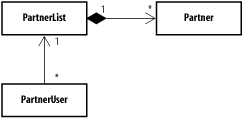 Figure 2-10 shows a PartnerUser class associated with the PartnerList via composite aggregation. If the PartnerList was simply an aggregation, each PartnerUser class could be associated directly with the relevant Partner class (which presumably contains information about the partnership relationship itself). In this case, however, the PartnerUser must be associated with the PartnerList instead, and it must use the PartnerList class to interact with the Partner data. 2.5.2 Describing Patterns with Class DiagramsThroughout most of this book, we use UML class diagrams to talk about patterns; here's an example. Figure 2-11 shows an implementation of the Gang of Four Strategy pattern. The Strategy pattern allows a client (in this case, the StrategyRunner class) to perform an action using different approaches determined by plug-in classes that conform to a standard interface. Figure 2-11. Strategy pattern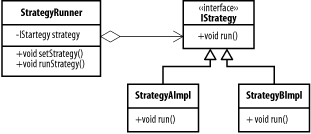 The StrategyAImpl and StrategyBImpl classes both implement the IStrategy interface, which includes a single method, run( ). At runtime, the application instantiates the appropriate strategy implementation and passes it to the setStrategy( ) method of the StrategyRunner, and then invokes the runStrategy( ) method. In real life, strategies could include persistence methods, cryptographic algorithms, message transports, or anything that might need to be done consistently in more than one way. 2.5.3 ObjectsClass diagrams are static; they describe the relationship between classes but don't show the state of a system at a particular time. Object diagrams can be used both to model the potential contents of a system and to gain a "snapshot in time" of the data that currently resides within a system. An object instance is represented as a box, just like a class, but the name is underlined. Objects are labeled as object name:class name; the object name or class name may be omitted. Omitting the object name indicates that the name of the particular class instance is not relevant to the diagram. The diagram in Figure 2-12 is fairly self-explanatory. The top compartment of the object contains the object name and class name, and the bottom compartments contain values for the fields. The lines between objects represent the associations. Associations do not need to be complicated. The presence of the objects themselves conveys most of the information about the types of associations that are permitted. Figure 2-12. Object diagram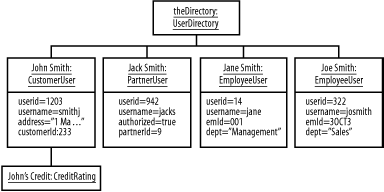 2.5.4 PackagesUML also provides a shape called a package. A UML package can be analogous to a Java package, or it can simply represent a group of classes with related functionality, regardless of underlying implementations. Creating packages within software projects is a good way to manage dependencies within applications, since the software can be dealt with in terms of the interfaces between packages rather than the interface between classes. This distinction makes it much easier to determine where changes to one area can affect others. Figure 2-13 shows a basic class diagram that documents the relationship between a Web Site, the Partnerships and Users domain objects, and three J2EE components. The servlets in the web site package depend on the J2EE servlets and JSP packages, as well as the JDBC package. They also depend on your own Partnerships and Users packages. The Users package also uses JDBC. Figure 2-13. Class diagram with packages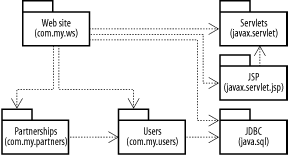 Note that there are no cycles in this diagram (Package A depends on Package B, which depends on Package A). While there is nothing in the UML to forbid cycles, recursive package dependencies generally reveal design and maintenance problems. When dependencies between packages loop back on themselves, it's generally time to either change the software or change the diagram. Again, we don't need a one-to-one link between packages on a package diagram and packages in the way we think of them in Java. Java packages are primarily a mechanism for code organization rather than design, and they generally interlock more than the design level packages in our diagrams. Packages can also be nested. This ability allows you to draw dependencies to either individual packages or to higher-level packages. Figure 2-14 shows the same package diagram as Figure 2-13, but it creates high-level packages for both the J2EE components and the application domain. Dependency arrows that cross over package borders connect single packages, while arrows from a package to an outer-level package show dependencies to the entire outer package. In this case, the code within the Web Site package is dependent on J2EE and the application domain, and the Users package within the application domain is dependent only on JDBC. Figure 2-14. Nested packages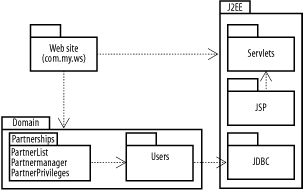 When we nest packages, we put the label on the tab, rather than in the main compartment. Within individual packages, we can list the interior classes (or embed full class diagrams, although that's unwieldy). |
| [ Team LiB ] |
|